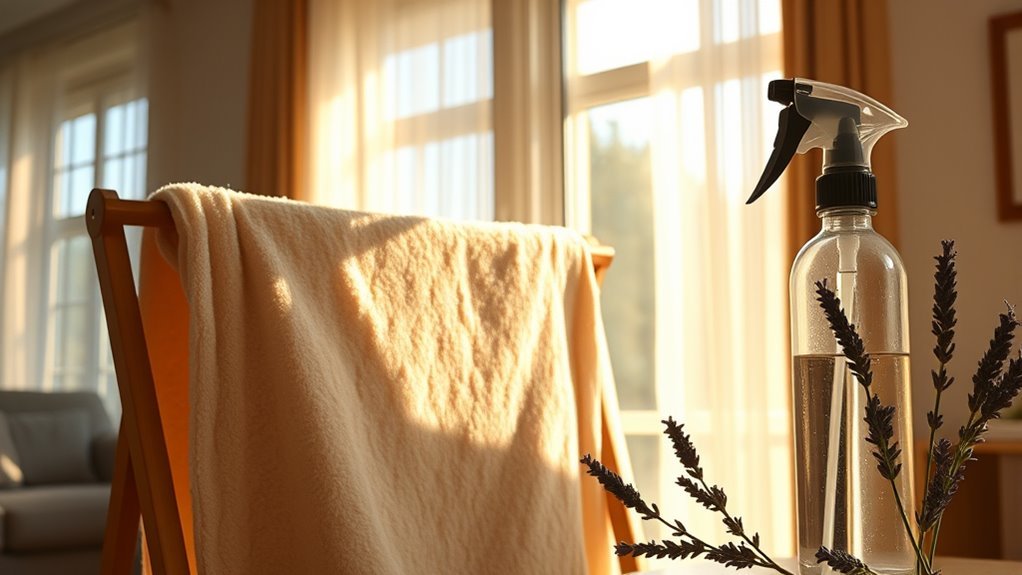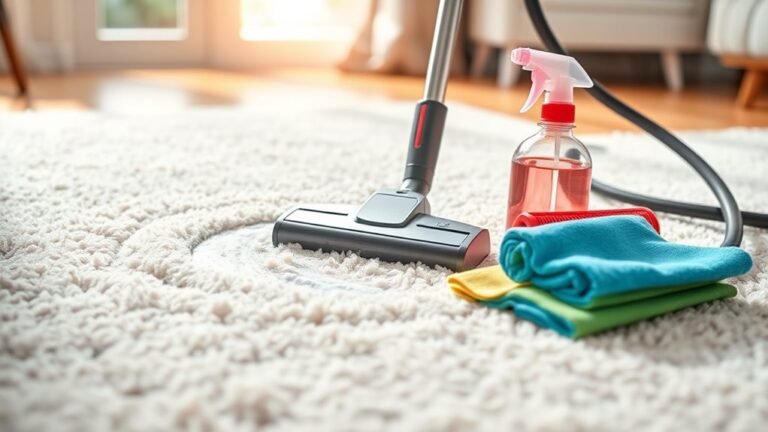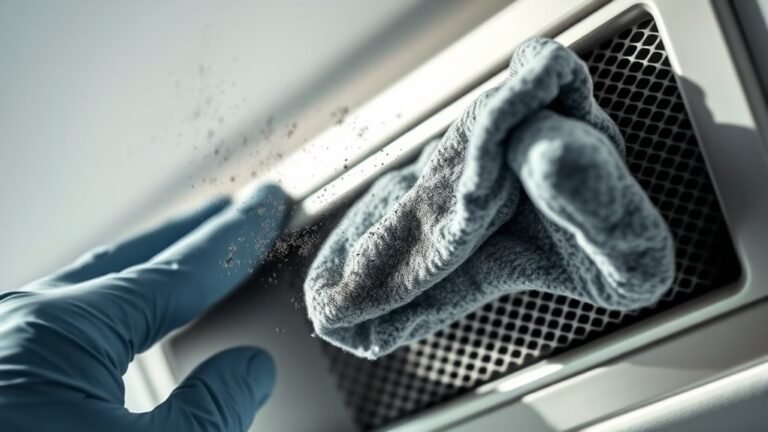Best Way to Sanitize Your Blanket
To sanitize your blanket effectively, first check its fabric type to choose safe cleaning methods. Use hot water (130°F–140°F) and a strong detergent in the washing machine’s sanitize cycle for deep cleaning. For a natural alternative, try a vinegar solution with essential oils to kill bacteria gently. Dry blankets thoroughly—sunlight or tumble drying works best—and store them in a cool, dry place to prevent germs. Keep your routine consistent to stay fresh and comfortable, and you’ll find simple ways to maintain your blanket’s cleanliness that fit your lifestyle.
Understanding Different Blanket Materials

Before you choose a method to sanitize your blanket, it’s important to understand the material it’s made from. Different blanket types, like cotton, wool, fleece, or synthetic blends, each demand specific fabric care to keep them safe and intact. Knowing your blanket’s fabric lets you pick a cleaning method that won’t damage it or reduce its softness. For example, wool requires gentle handling and cool water, while synthetic fabrics often handle hotter temperatures well. Ignoring fabric care can lead to shrinking, discoloration, or weakened fibers, trapping dirt and germs instead of removing them. By understanding the material, you free yourself to sanitize effectively without the risk of ruining your cozy companion. This knowledge is your first step toward a cleaner, fresher blanket.
Importance of Regular Blanket Sanitization
Although you might not think about it often, regularly sanitizing your blanket is essential for maintaining a healthy living environment. Keeping up with blanket hygiene prevents the buildup of dust mites, bacteria, and allergens that can affect your respiratory health and overall well-being. When you prioritize cleanliness, you enjoy clear health benefits like reduced allergy symptoms and better sleep quality. Plus, regularly sanitized blankets feel fresher and more comfortable, giving you the freedom to relax fully without worry. By making blanket sanitation a routine, you take control of your personal space and create a healthier, more inviting environment. It’s a simple step that protects your health and enhances your comfort, supporting the freedom to live well every day.
Machine Washing Techniques for Sanitizing Blankets

When you’re machine washing your blanket to sanitize it, using the right water temperature is key—usually hot water works best for killing germs. You’ll also want to pick a detergent that’s strong enough to eliminate bacteria but gentle enough to protect your blanket’s fabric. These simple choices can make a big difference in how clean and safe your blanket gets.
Optimal Water Temperature
Since water temperature plays an essential role in sanitizing your blanket, you’ll want to choose the right setting on your washing machine. Following water temperature guidelines guarantees you kill germs effectively without damaging your blanket’s fabric. Generally, hot water—around 130°F to 140°F—is ideal for most blankets, as it thoroughly sanitizes while loosening dirt. However, some fabrics need cooler temperatures to avoid shrinking or fading. Always check your blanket’s care tag and match blanket washing temperatures accordingly. If your washing machine offers a sanitize cycle, it’s designed to maintain proper heat, giving you peace of mind. By understanding and following these temperature rules, you can confidently clean your blanket, keeping it fresh and hygienic while embracing the freedom of easy, effective care.
Detergent Selection Tips
Choosing the right detergent is key to effectively sanitizing your blanket during machine washing. You want to pick detergent types that not only clean thoroughly but also preserve your blanket’s texture and color. Look for options labeled specifically for sanitizing or those with antibacterial properties to guarantee germs are eliminated. If you care about the environment and your freedom to live sustainably, eco friendly options are a smart choice—they clean well without harsh chemicals that can damage fabrics or pollute waterways. Avoid detergents with excessive fragrances or additives, as they can irritate your skin or leave residues. By selecting the proper detergent type, you maintain your blanket’s comfort and cleanliness, giving you peace of mind and the freedom to enjoy a fresh, sanitized blanket every time.
Using Natural Cleaning Agents to Sanitize Blankets
Although commercial sanitizers are effective, using natural cleaning agents to sanitize your blanket offers a gentle yet powerful alternative that’s safe for both your fabric and the environment. You can create a simple vinegar solution by mixing one part white vinegar with three parts water. This combo naturally kills bacteria without harsh chemicals. For an added fresh scent and extra antimicrobial boost, add a few drops of essential oils like tea tree or lavender. Just spray the solution lightly on your blanket or add it during the rinse cycle of your wash. This method lets you keep your blanket clean and fresh while staying true to your values of freedom and eco-conscious living. Embracing natural agents means you won’t compromise on sanitation or your desire for a chemical-free lifestyle.
How to Safely Use Disinfecting Sprays on Blankets

Natural cleaning agents offer a gentle way to sanitize your blanket, but sometimes you might want a quicker or stronger option. When using disinfecting sprays, you’ve got to prioritize disinfecting spray safety. Start by checking the label to verify the spray is safe for your blanket’s material compatibility—some fabrics can be damaged by harsh chemicals. Test a small hidden area first to avoid discoloration or weakening fibers. Spray lightly and evenly, avoiding oversaturation, which can leave your blanket damp and promote mildew. Always use sprays in a well-ventilated space to protect your lungs. Let the blanket air dry completely before using it again. By following these steps, you keep your blanket clean without sacrificing its texture or your freedom to enjoy it comfortably.
Dry Cleaning Options for Sensitive Fabrics
When your blanket is made from delicate or sensitive fabrics, traditional washing methods might do more harm than good. You’ll want to explore dry cleaning methods to maintain fabric care without risking damage. Dry cleaning uses solvents instead of water, making it ideal for sensitive materials like silk or wool. Here’s a quick guide to help you choose the right dry cleaning option:
| Dry Cleaning Method | Best For |
|---|---|
| Professional Dry Clean | All delicate fabrics |
| At-home Dry Cleaning Kit | Light stains, easy care |
| Spot Cleaning | Small stains, quick fix |
| Eco-friendly Dry Clean | Environmentally conscious |
| Wet Cleaning | Sensitive but washable |
Choosing the right dry cleaning method means preserving your blanket’s integrity while keeping it fresh and sanitized—freedom in fabric care!
Tips for Removing Allergens and Dust Mites
To effectively remove allergens and dust mites from your blanket, you’ll want to use hot water washing techniques that kill these tiny irritants. You can also try allergen-reducing fabric sprays for an extra layer of protection between washes. These simple steps help keep your blanket fresh and allergy-friendly.
Effective Washing Techniques
Although regular washing is essential, using the right techniques can make a huge difference in removing allergens and dust mites from your blanket. Start by checking the care label to guarantee you’re following the best blanket care practices. Wash your blanket in hot water—at least 130°F—to effectively kill dust mites and break down allergens. Use a gentle, fragrance-free detergent to protect the fabric while maintaining cleanliness. Avoid overloading your machine; blankets need room to move for thorough cleaning. After washing, dry your blanket completely on a high heat setting to eliminate any remaining allergens. Proper fabric maintenance extends your blanket’s life and keeps it fresh, giving you the freedom to enjoy restful, allergen-free sleep without compromise.
Allergen-Reducing Fabric Sprays
How can you quickly reduce allergens and dust mites on your blanket between washes? Allergen-reducing fabric sprays are your best bet. These sprays act as effective allergen barriers, neutralizing dust mites and other irritants without the hassle of a full wash. Simply spritz your blanket with a fabric freshener designed to target allergens, and let it dry. This method keeps your blanket feeling fresh and safe, giving you freedom from constant laundering. Plus, it’s perfect for quick refreshes when life’s busy, letting you maintain a clean, allergen-free space effortlessly. Just make sure to choose a spray that’s safe for your blanket’s material and follow the instructions. With allergen-reducing fabric sprays, you’re free to breathe easy and enjoy your cozy comfort without worry.
Proper Drying Methods to Maintain Cleanliness
Since moisture can encourage bacteria and mold growth, drying your blanket thoroughly is essential for maintaining its cleanliness. You want to embrace drying techniques that free you from worries, like sun exposure, which naturally disinfects and refreshes your blanket. Whether you hang it outdoors or use a dryer, the goal is complete dryness.
| Drying Technique | Benefits | Feelings Evoked |
|---|---|---|
| Sun Exposure | Natural sanitizing | Empowerment, freedom |
| Tumble Drying | Quick, convenient | Comfort, ease |
| Air Drying | Gentle, eco-friendly | Calm, peace |
| Combination | Versatile | Confidence, control |
Master these methods, and you’ll keep your blanket clean and ready to wrap yourself in freedom.
Storing Blankets to Prevent Germ Growth
To keep your blanket germ-free, it’s important to store it in the right conditions, avoiding damp or humid areas. You’ll want to control moisture by using silica packets or airing your blanket regularly. Also, protective covers can shield your blanket from dust and bacteria while it’s tucked away.
Optimal Storage Conditions
Even if your blanket is freshly sanitized, improper storage can quickly lead to germ buildup. To keep your blanket fresh and free from germs, maintain ideal temperature and humidity levels. Aim for a cool, dry space—this freedom from dampness stops bacteria and mold from thriving. Here’s a quick guide to best storage conditions:
| Condition | Ideal Range | Why It Matters |
|---|---|---|
| Temperature | 60-75°F (15-24°C) | Prevents heat from fostering germs |
| Humidity Levels | 30-50% | Controls moisture to avoid mold |
| Airflow | Good circulation | Keeps blanket fresh and dry |
Stick to these conditions, and you’ll enjoy a clean, germ-free blanket every time you grab it.
Moisture Control Techniques
Maintaining the right storage conditions sets the stage for effective moisture control, which is key to preventing germ growth on your blanket. You want to minimize moisture absorption by keeping your blanket in a dry, well-ventilated space. Avoid damp closets or basements where humidity control is difficult. Using a dehumidifier or moisture-absorbing packets can help keep the air around your blanket dry, cutting off the environment germs need to thrive. When you store your blanket, make sure it’s completely dry to prevent any trapped moisture from encouraging mold or bacteria. By managing humidity control and moisture absorption, you’re taking a straightforward step to keep your blanket fresh and germ-free, letting you enjoy true freedom from worry when you wrap yourself up.
Use of Protective Covers
Although proper moisture control is essential, using protective covers adds an extra layer of defense against germs on your blanket. You want to keep your blankets fresh and germ-free, and choosing the right protective cover materials makes all the difference. Here’s how the blanket cover benefits help you maintain freedom from unwanted bacteria:
- Breathable fabrics like cotton or bamboo prevent moisture buildup while blocking dust and allergens.
- Waterproof liners guard against spills and dampness, stopping mold and mildew growth.
- Zippered or tightly sealed covers create a barrier that keeps germs out during storage.
Frequency Recommendations for Sanitizing Blankets
How often you should sanitize your blanket depends on its usage and exposure to dirt or allergens. If you’re someone who uses your blanket daily or has pets around, you’ll want to increase your cleaning frequency to once every one to two weeks. For occasional use or in a low-traffic environment, sanitizing once a month is usually enough. Remember, good blanket care isn’t just about cleanliness; it’s about preserving your freedom to relax without worry. If allergies or sensitivities are a concern, consider more frequent sanitizing to keep irritants at bay. Ultimately, listen to your lifestyle and adjust your routine accordingly—your blanket should feel fresh whenever you wrap yourself up in it. Staying consistent with your cleaning frequency helps maintain both comfort and hygiene effortlessly.
Frequently Asked Questions
Can UV Light Effectively Sanitize Blankets?
You might wonder if UV light is effective for sanitizing your blanket. UV effectiveness depends on exposure time and intensity, but it can kill many germs without chemicals. However, you should be cautious about blanket safety since prolonged UV exposure might weaken fibers or cause fading. If you want a chemical-free option, UV can be handy, but always balance sanitizing power with preserving your blanket’s integrity.
Are Sanitizing Wipes Safe for Quick Blanket Cleaning?
Imagine you’re camping and want to freshen your blanket fast—sanitizing wipes can be a handy quick cleaning alternative. They offer decent sanitizing wipe effectiveness on surface germs, perfect when washing isn’t an option. Just remember, they won’t replace deep cleaning but help you regain that fresh feeling on the go. So, if you’re craving freedom from bulky laundry, wipes can be your instant, portable solution.
How Does Sanitizing Affect the Longevity of Blankets?
Sanitizing frequency plays a big role in how long your blanket lasts. If you sanitize too often, especially with harsh chemicals, it can wear down certain blanket materials like wool or delicate cotton. You want to balance keeping things clean without sacrificing the fabric’s integrity. Consider the material type and how often you actually need to sanitize—sometimes airing out your blanket can give you that fresh feeling without overdoing it.
Can Freezing Blankets Kill Bacteria and Germs?
Did you know that some bacteria can survive freezing temperatures? While freezing methods can slow down or temporarily halt bacterial growth, they don’t necessarily kill all blanket bacteria. So, if you’re thinking freezing your blanket will sanitize it completely, it won’t free you from germs entirely. To truly cleanse your blanket, you’ll want a method that actively destroys bacteria, not just pauses their activity. Stay free and clean!
Is It Safe to Sanitize Blankets With Bleach Regularly?
You shouldn’t use bleach regularly on your blankets because it can damage certain blanket materials and cause colors to fade. Instead, consider bleach alternatives like vinegar or baking soda, which are gentler yet still effective. These options let you keep your blankets fresh without sacrificing their texture or durability. You deserve the freedom to sanitize safely while preserving your favorite cozy layers, so choose methods that protect both you and your blanket.






